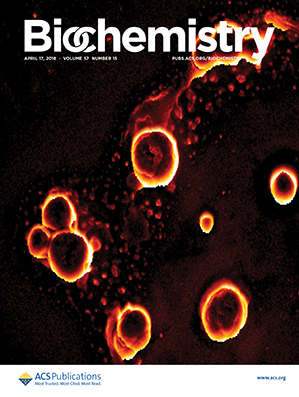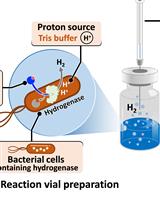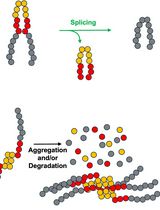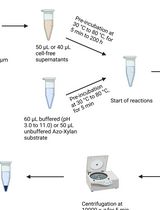- EN - English
- CN - 中文
Kinetic Characterization of the Shigella Type Three Secretion System ATPase Spa47 Using α-32P ATP
利用α-32P ATP研究志贺氏菌的III型分泌系统ATP酶Spa47的动力学表征
发布: 2018年11月05日第8卷第21期 DOI: 10.21769/BioProtoc.3074 浏览次数: 5522
评审: Andrea PuharLionel SchiavolinKanika Gera
Abstract
ATPases represent a diverse class of enzymes that utilize ATP hydrolysis to support critical biological functions such as driving ion pumps, providing mechanical work, unfolding/folding proteins, and supporting otherwise thermodynamically unfavorable chemical reactions. We have recently shown that the Shigella protein Spa47 is an ATPase that supports protein secretion through its specialized type three secretion apparatus (T3SA), supporting infection of human host cells. Characterizing ATPases, such as Spa47, requires a means to accurately determine enzyme activity (ATP hydrolysis) as a function of time, reaction conditions, and potential cofactors, regulators, inhibitors, etc. Here, we describe a detailed protocol for characterizing the enzyme kinetics of Spa47 using a direct α-32P ATPase assay.
Keywords: ATPase (ATP酶)Background
The study of enzyme kinetics arguably gave rise to the field of biochemistry and remains an important and diverse area of research today. While many important factors are considered when characterizing enzyme kinetics, they ultimately all rely on a robust and accurate means of determining the rate of enzyme-catalyzed product formation under a series of carefully controlled conditions. One important and highly diverse class of enzymes includes those that couple the hydrolysis of ATP to downstream processes such as driving ion pumps, providing mechanical work, unfolding/folding proteins, and supporting otherwise thermodynamically unfavorable chemical reactions (Stock et al., 2000; Sauer et al., 2011; Miller et al., 2016). Despite what processes these enzymes are ultimately responsible for, they are all collectively referred to as ATPases for the critical role ATP hydrolysis plays in their overall function.
The biological importance and diversity of ATPases have driven the development of several methods to quantify ATPase activity. Examples include a wide range of enzyme-coupled assays that rely on the generation of either ADP or inorganic phosphate to support a subsequent enzyme-catalyzed reaction or series of reactions to ultimately generate a product that provides a detectable change in signal (often photon absorbance) (Sehgal et al., 2016; Hoskins et al., 2018). This provides a means for real-time monitoring of ATP hydrolysis though conditions for each enzyme-catalyzed reaction in the scheme must be carefully considered and can limit the utility of this method. Some colorimetric and fluorescence assays have more recently been developed to monitor ATP depletion or product generation without the need for coupling to additional enzyme-catalyzed reactions, but they remain reliant on interaction/reaction with reporter proteins/molecules and can be highly sensitive to reaction buffer composition and contamination (Soyenkoff, 1947; Baykov et al., 1988; Li et al., 2005). Perhaps one of the most robust means for monitoring ATP hydrolysis relies on a radioactive ATP substrate such as γ-32P ATP or α-32P ATP. The radioactive 32P ATP substrate is hydrolyzed by the enzyme, producing either ADP and 32P (inorganic phosphate) or α-32P ADP and inorganic phosphate from γ-32P ATP and α-32P ATP, respectively (King, 1995). The radioactive products and remaining substrate can then be separated by thin layer chromatography, detected by exposure to either film or a storage phosphor screen and the concentration of product formed quantified as a function of time the reaction was allowed to proceed during the assay. Though this method does not readily support real-time monitoring of product formation, it carries many inherent advantages including high signal-to-noise, capability with essentially any buffer conditions required to support enzyme stability, and no downstream coupling reactions required for product detection/quantitation.
Here, we provide a detailed α-32P ATP hydrolysis protocol for kinetic characterization of the Shigella type three secretion system ATPase, Spa47 that has provided insight into working with this specific protein (Burgess et al., 2016a and 2016b; Case and Dickenson, 2018). This protocol is intended, however, to serve as a guide for the characterization of any enzymes that hydrolyze ATP as the basis of the protocol is unchanged by the enzyme being studied.
Materials and Reagents
- Nitrile gloves
- Low retention pipette tips (VWR, catalog numbers: 89187-848, 89079-476 and 89079-486)
- PEI Cellulose F TLC plates (Millipore, catalog number: 105579)
- 0.65 ml Microcentrifuge Tubes (VWR, catalog number: 87003-290)
- Plastic wrap
- Soft Pencil
- Permanent marker
- Sterile 0.22 μm PVDF syringe Filter (Sartorius, catalog number: 17761-Q)
- Container for collecting 32P-contaminated pipette tips and tubes (VWR, catalog number: 13915-114)
- Bovine Serum Albumin (BSA) (Thermo Fisher Scientific, catalog number: 23209)
- Dithiothreitol (DTT) (Gold Bio, catalog number: DTT100)
- 12% SDS-PAGE gel(s) (Bio-Rad, catalog number: 4561046)
- BLUEstain Protein Ladder (Gold Bio, catalog number: P007-500)
- Adenosine triphosphate (ATP) (Sigma-Aldrich, catalog number: A2383)
- Ethylenediaminetetraacetic acid (EDTA) Disodium, dehydrate (Gold Bio, catalog number: E-210-1)
- Tris-HCl (VWR Life Science, catalog number: 77-86-1)
- NaCl (Sigma-Aldrich, catalog number: 7647-14-5)
- SDS (Ameresco, catalog number: M107-500G)
- NaN3 (Sigma-Aldrich, catalog number: S2002)
- Glycine (VWR Life Sciences, catalog number: 56-40-6)
- Acetic acid (Pharmco AAPER, catalog number: 281000ACSCSLTGL)
- Methanol (Fischer Chemical, catalog number: 67-56-1)
- Coomassie blue R250 (Gold Bio, catalog number: C-461-100)
- Magnesium chloride (MgCl2) Anhydrous (Ameresco, catalog number: J364-500G)
- α-32P ATP (PerkinElmer, catalog number: BLU003H250UC)
- Potassium monophosphate (K2HPO4) (VWR Life Science, catalog number: 0781-1KG)
- Bromophenol blue
- Glycerol
- Milli-Q water
- NaOH
- 1 M MgCl2
- 3x SDS sample buffer (see Recipes)
- SDS running buffer (see Recipes)
- Total protein SDS-PAGE gel stain (see Recipes)
- SDS-PAGE gel de-stain (see Recipes)
- Spa47 buffer (see Recipes)
- ATP reaction Mix (see Recipes)
- Potassium monophosphate (K2HPO4) buffer (see Recipes)
- 0.5 M EDTA, pH 7.9 (see Recipes)
Note: Many of these reagents can be hazardous. Please familiarize yourself with the potential hazards of each chemical prior to performing this protocol.
Equipment
- Ruler
- Timer
- Microcentrifuge Tube rack(s)
- Thermal cycler
- Rocking platform
- -20 °C freezer
- Electrophoresis system and modules for SDS-PAGE (Bio-Rad, catalog number: 125BR)
- Electrophoresis power supply (Bio-Rad, model: PowerPac 300)
- Adjustable pipettes (Eppendorf, catalog numbers: 3120000011, 3120000020, 3120000046, 3120000038 and 3120000062)
- Gel imager (Bio-Rad Chemi Doc MP imaging system)
- Spectrophotometer (Thermo Spectronic, model: Genesys 10 UV)
- Space designated (approved) for radioactive work
- Radiation shield (Nalgene, catalog number: 6700-1812)
- Geiger counter (Technical Associates, model: TBM-15)
- Vortexer mini (VWR, catalog number: 58816-121)
- TLC developing tank (Sigma-Aldrich, catalog number: Z126195-1EA)
- Storage phosphor screen (Kodak, model number: SO230)
- STORM 860 scanner (Molecular Dynamics)
Software
- Image Lab Software 5.2.1 (Bio-Rad Laboratories)
- Image Quant 5.1 (Molecular Dynamics)
- Microsoft Excel (Microsoft)
- Sigma Plot 12 (Systat Software)
- ImageJ
- STORM scanner control software
Procedure
文章信息
版权信息
© 2018 The Authors; exclusive licensee Bio-protocol LLC.
如何引用
Case, H. B. and Dickenson, N. E. (2018). Kinetic Characterization of the Shigella Type Three Secretion System ATPase Spa47 Using α-32P ATP. Bio-protocol 8(21): e3074. DOI: 10.21769/BioProtoc.3074.
分类
微生物学 > 微生物生物化学 > 蛋白质 > 活性
生物化学 > 蛋白质 > 活性
分子生物学 > 蛋白质 > 去磷酸化
您对这篇实验方法有问题吗?
在此处发布您的问题,我们将邀请本文作者来回答。同时,我们会将您的问题发布到Bio-protocol Exchange,以便寻求社区成员的帮助。
Share
Bluesky
X
Copy link












